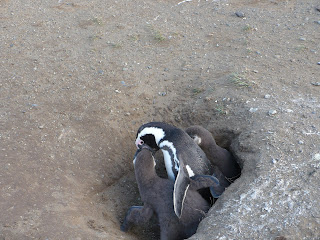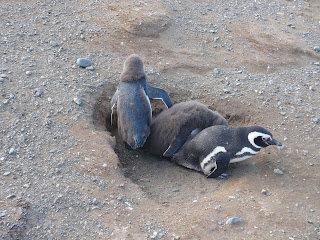
There are no trees on this island. The winds were so strong it was impossible to make it to the top of the hill where there is a lighthouse. The main reason the penguins come here is because of the amount of daylight that the island receives, with sunrise around 4:30 am and sunset at 11:00 pm.

The babies are fighting to be fed by their mother. Here is a clear picture of the mother feeding one of her young, with its head inside her mouth.

Adult penguin (with stripe on the front) and two babies. You can see the baby molting its feathers on its back.

Here are the burrows that the male penguins prepare for the females to lay their eggs and in which the babies stay until they molt their feathers and head to the sea in April.

Penguins came out to greet us as we got off the boat and a few had to be shooed away when the front gate was lowered.

From Punta Arenas we took a boat out to Magdalena Island to see the Magellanic penguins who come from Brazil in September to breed here before departing again in April. The island is in the middle of the Magellan Strait. There were about 70,000 penguins here - adults, babies and juveniles.

The following day we headed to Punta Arenas where we found the Chilean Benihana version of Philadelphia cheesesteaks. This guy was a real artist, flipping steaks and burgers to fit on hamburger-like buns the size of plates, layered with tomatoes, lettuce, onions, guacomole, mayo and cheese. You can`t ask for anything much better.

We stopped to see this beautiful waterfall of pristine, turquoise glacial water - from 2 to 6 degrees Celcius.

We headed out on what seemed like an endless beach to view Gray Glacier, Torres del Paine´s version of Perito Moreno. The wind was so strong it was like walking through a sand storm.

Our second day, we took a tour to Torres del Paine National Park, Chile´s most spectacular national park. Behind us are the Torres, three towers reaching to over 9000 feet.
On the way back to Puerto Natales, we came out of the border crossing office to this sunset!
As we approached this ice cave on the glacier, the wind whipped up. We were actually lucky the day we went. Winds in the area generally range from 35 - 65 mph, but they were nowhere near that while we were there.
We took a boat ride out to the glacier, which brought us close to it, where you can get a sense of its mass.
Los Glacieres National Park has over 300 glaciers. Perito Moreno is the second largest and is still growing, although pieces are constantly breaking off. A series of walkways allows visitors to view Perito Moreno and, while we were there, we saw several chunks - one as big as a semi-trailer - fall into the lake.

From Puerto Natales (Chile), our home base, we took several tours. The first day we headed to Argentina to visit Los Glacieres National Park to see Perito Moreno, an incredible glacier. En route, we passed through the Argentinian side of Patagonia - a vast desert, quite different from the Chilean side, which has more rainfall and is greener.




No comments:
Post a Comment